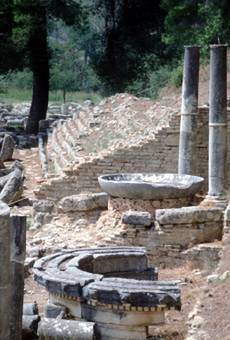Olympic Games (ancient)
Olympic Games (ancient), most famous of the four great national festivals of the ancient Greeks, the other three being the Isthmian Games, the Pythian Games, and the Nemean Games (see Games, Ancient). The ancient Olympic Games were celebrated in the summer every four years in the sanctuary of the god Zeus at Olympia. The history of the games dates from 776 bc.
Early in the year of the Games, envoys were sent throughout the Greek world to invite the city-states to join in paying tribute to Zeus. The city-states then dispatched groups to vie with one another in the splendor of their equipment and the proficiency of their athletic feats. The competitions were open only to honorable men of Greek descent.
The order of the events is not precisely known, but the first day of the festival was devoted to sacrifices. The second day began, in all probability, with footraces, for which the spectators gathered in the stadion, an oblong area enclosed by sloping banks of earth. On other days wrestling, boxing, and the pancratium, a combination of the two, were held. In the first of these sports the object was to throw the antagonist to the ground three times. Boxing became more and more brutal; at first the fighters wound straps of soft leather over their fingers as a means of deadening the blows, but in later times hard leather, sometimes weighted with metal, was used. In the pancratium, the most rigorous of the sports, the contest continued until one of the participants acknowledged defeat.
Horse racing, in which each entrant owned his horse, was confined to the wealthy but was nevertheless a popular attraction. After the horse racing came the pentathlon, a series of five events: wrestling, discus throwing, javelin hurling, long jumping, and sprinting. The exact sequence of the sports and the method used to determine the winner are not known. The discus was a plate of bronze, probably lens shaped. The javelin was hurled with the aid of a strap wound about the shaft, producing a rotary motion for greater distance and accuracy. The jumping event was judged for distance, not for height. The closing event was a race run in armor. The victors were awarded crowns of wild olive. Celebrated by poets, they often lived for the rest of their lives at public expense.
The ancient Olympic Games reached the height of their popularity in the 5th and 4th centuries bc. In about ad 393 Roman emperor Theodosius I suppressed them. The concept of the Olympic Games was revived in the late 1800s. For an account of the modern games, see Olympic Games (modern).

Vanni/Art Resource, NY
Ruins at Olympia
The site of the ancient Olympic Games was a sanctuary consisting of temples and buildings to honor the mythological gods of ancient Greece. The games began with a ceremony and sacrifice to the gods. The exedra, or sitting area, pictured here is among the ruins at Olympia.
Olympia (Greece)
Olympia (Greece), site of the ancient Olympic Games, which were celebrated every four years by the Greeks. Olympia was situated in a valley in Elis, in western Pelopónnisos (Peloponnesus), through which runs the Alpheus River. It was not a town, but only a sanctuary with buildings associated with games and the worship of the gods. Olympia was a national shrine of the Greeks and contained many treasures of Greek art, such as temples, monuments, altars, theaters, statues, and votive offerings of brass and marble. The Altis, or sacred precinct, enclosed a level space about 200 m (about 660 ft) long by nearly 177 m (nearly 580 ft) broad. In this were the chief centers of religious worship, the votive buildings, and buildings associated with the administration of the games.
The most celebrated temple was the Temple of Zeus, dedicated to the father of the gods. In this temple was a statue of Zeus made of ivory and gold, the masterpiece of the Athenian sculptor Phidias (see Seven Wonders of the World). Next to the Temple of Zeus ranked the Heraeum, dedicated to Hera, the wife of Zeus. In this temple, probably the oldest Doric building known, stood the table on which were placed the garlands prepared for the victors in the games. The votive buildings included a row of 12 treasure houses and the Philippeum, a circular Ionic building dedicated by Philip II, king of Macedonia, to himself. Outside the Altis, to the east, were the Stadium and the Hippodrome, where the contests took place; on the west were the Palaestra, or wrestling school, and the Gymnasium, where all competitors were obliged to train for at least one month. The French began excavations here in 1829. German explorations of 1875-81 threw much light upon the plans of the buildings; they were resumed in 1936, 1952, and 1960-61. Many valuable objects were discovered, the most important of which was a statue of Hermes, the messenger of the gods, by Praxiteles.